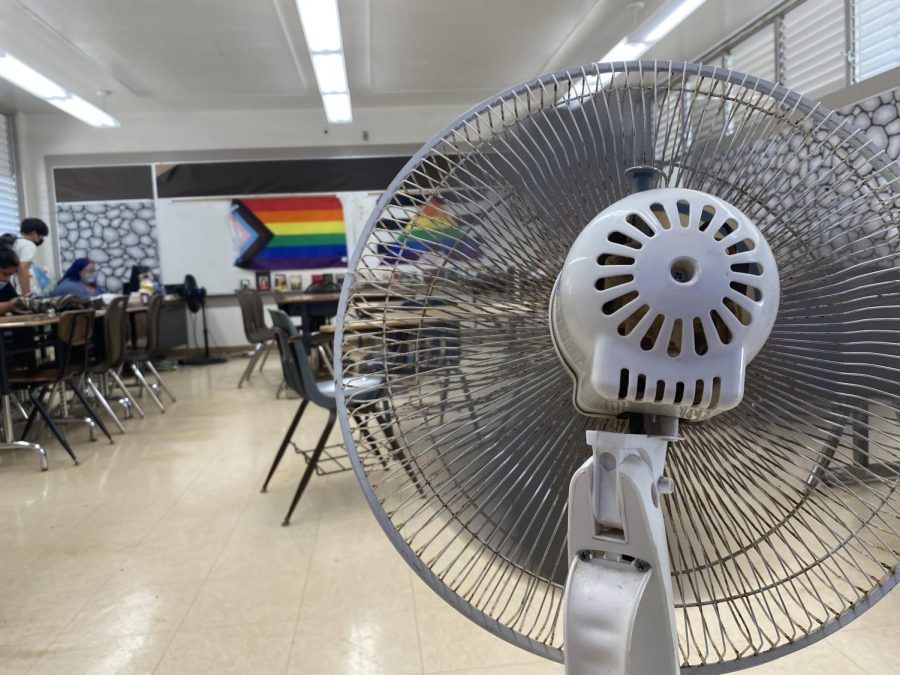Hot Classroom Temperatures Negatively Affects Learning
By Dominic Niyo
Evon Le’s classroom F154 is one of many without air-conditioning. Instead, it’s cooled with a limited amount of fans for the whole class to share.
October 5, 2022
Since many classrooms in Hawaii have no air conditioning, it’s tough to concentrate on studies when it’s unbearably hot.
The summer season, which lasts from May to October, has an average temperature of 85°F daily, making the beginning and end of the school year unpleasantly hot. Furthermore, overheated classrooms can leave students feeling exhausted, irritated and discouraged.
A research project conducted by the Harvard Kennedy School of Government in 2018 examined 21 million test scores from 10 million high schools nationwide and compared them to temperature data. The study discovered that “Without air conditioning, each 1°F increase in a school year’s temperature reduces the amount learned that year by one percent,” meaning that even the slightest temperature increase can have a significant impact on a student’s learning.
Additionally, overheated classrooms in severe temperatures can induce weariness, nausea and even heat stroke in both students and teachers.
Back in 2015, an Ewa Elementary School teacher was sent to the ER due to heat exhaustion. According to Hawaii News Now, the teacher felt dizzy and started to really feel fatigued. The doctors later added that, due to her present health situation, it could have likely resulted in heat stroke.
To combat the high temperatures of her non-air-conditioned classroom, she had to spend her own money to keep herself and her students cool, but even that wasn’t enough. Many of her students’ parents have also informed her that their children looked pale, felt fatigued, and some even started to vomit.
At McKinley High School, we face a similar problem. Fortunately, nobody in our school had to be sent to the ER due to insufficient cooling systems, but many of our faculty members, including English teacher Evon Le, have experienced symptoms of exhaustion due to the hot temperatures of their non-air-conditioned classroom.
“I have experienced fatigue in the classroom, especially when it is during the early start of the year and near the end of the year because that’s when it’s getting hotter,” Le said. “I always have to bring a water bottle to keep cool.”
Many students like me who enjoy participating in extracurricular activities such as playing sports during lunch often find it challenging to cool off in a hot class room.
Le has observed this situation and claims that her students are often left feeling exhausted.
“By the time they get to class, they have very low motivation when the classroom is really hot, so air conditioning would definitely help, and I think it would encourage students to come to class,” Le said.
The Department of Education has consistently funded cooling systems, primarily in elementary schools. In my opinion, they should now try to provide the same funding for middle and high schools, because the main issue that many of these schools are facing is a shortage of government funds. According to Le, these upgrades can be quite expensive.
“When us teachers reached out to talk to the principal about it, he said that basically what’s happening is that there is a lack of funds from the government itself that is able to give money.” Le said. “If the fans unexpectedly break down, I always feel like I have to get my own funding, and even in terms of that, it’s very limited because it’s between buying more fans or getting school supplies.”
Many dedicated teachers nationwide have been known to spend their own money to better improve their students’ learning, so why is the richest country in the world in terms of gross domestic product unable to keep up with the costs of their own youth? A sufficient amount of educational funding ensures that both students and teachers can have better learning environments, which will likely lead to higher productivity and graduation rates.





